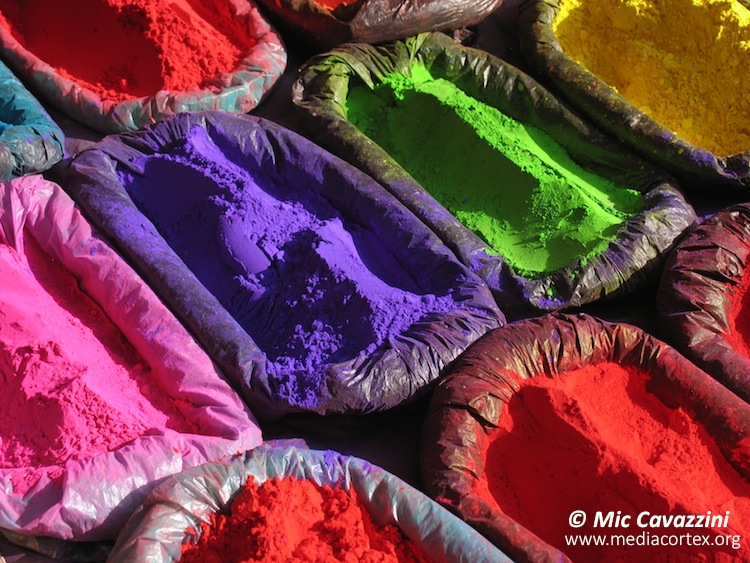Since my camera was stolen outside Rishikesh, I didn’t photograph any of the places described below. Ironically, I’ve tried to capture the mood of the ‘real India’ using other pictures from Assam and Nepal.
***
UTTARKHAND
After the bone rattling bus trips Spiti I’m looking forward to some R&R. I plow through to Rishikesh which immediately reveals creature comforts. Coffee, wi-fi and lassis are found everywhere for this is the ‘yoga capital of the world.’ I feel a bit self-conscious in my sensible trekker clothes as the lithe disciples here are all in flowing linen pants, jesus sandals, and the dreamy benevolent gaze of the earnestly enlightened. Despite all the sell, the town has a genuine pulse from the historic ashrams and ceremonial piers (ghats) that line the banks of the Ganga. Every evening as the sun melts away, there builds an intensity around the river with more and more people coming to wash and pray. They leave flowers floating on the water and scatter food offerings to the god Rama, and then cluster around little altars where the swamis light oil candelabras.
One day I’m loitering by a peaceful beach backed by greenery and poky private ashrams with peeling paint. A wizened old man in bright orange robes is sitting on a bench and calmly cleaning his chillum. He catches my eye and waves me over. Shining forehead and long white beard perfect for grabbing in meditative thought. He doesn’t speak English but offers me the pipe with a cheeky grin. “When in Rome” I figure, and after a briefly muttered prayer of thanks to the earth, I take a draw. We pass it back and forth and I ask about the community with exaggerated gestures and facial expressions. The old saddhu launches into a tale of lord Ram and Vishnu and he mimes epic battles by drawing his arm into the firing of a bow. He intones the deities and hammers with his fists at the outcomes of a demonic clash right HERE he points at the riverbank. “Rishikesht. RishiKESHT!” he repeats with wild eyes. I nod, “Achaa….” as if I understand he is teaching me an etymological lesson here too.
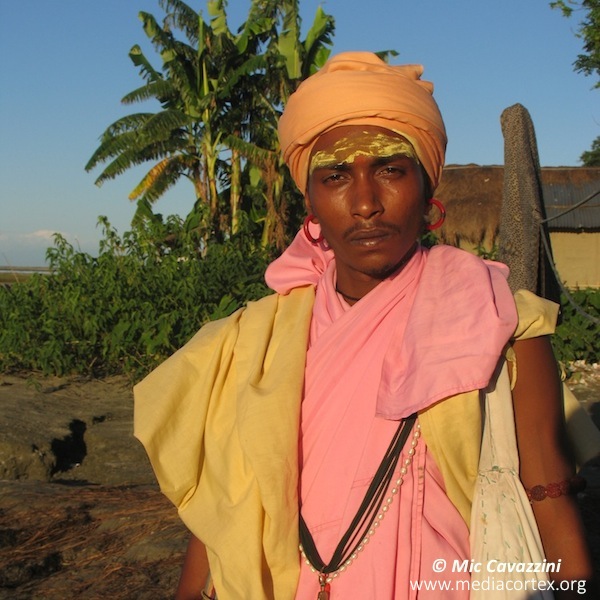
I pull out my map and ask about the sources of the holy river – and he gets even more animated as he point to the Gangotri glacier, the Yamuna river, the Mandakini and the Alakndanda. The temples at each of thee sights are must-do pilgrimages for every Hindu, and the confluences at which they merge are also festooned with ghats and temples. The tales go on for some time, but we also sit placidly watching the mighty river drift by, with arms stretched across each other’s shoulders like old mates. Only when I go to leave and say goodbye is the spell broken by his request for some money. “But I already left you some cigarettes!” I protest, “I thought we were just hanging out!?” He tries the puppy dog eyes, but laughs along is happy enough with the gift I leave him.
That evening I meet another saddhu who does speak excellent English, having given up a professional life. He seems to have seen much and has a wry and reflective answer for everything. “How much did he ask you for?” he laughs. “Was he wearing orange? Most of those are just taking advantage of the tourist and the Indians. And the yoga schools! The gods don’t need money- If anyone asks you for money they are not real gurus. You need exercise? Go to the gym.” He makes me sit up straight, spine drilling into the earth, and breath to the bottom of my gut, and tells me to come back at 6am to really practice. “Not lesson. No money,” he insists. His own temple is no bigger than a shack. When I toss my shoes off he says, “No! If you had to walk everywhere you’d appreciate the value of good shoes. I’ve been to avery temple between here and Nepal- always walking.” I jibe him for the Thermarest he has in the corner. “ I don’t need many things but useful things I treasure!”

Much later while walking in the mountains I pass a wiry saddhu dragging a huge log up to his isolated ‘dharamsala’, or place of peace– just a little shack built into the rock at a woodland shrine that marks where Shiva’s hair fell when he was defeated by a demon. Again, half an hour of animated storytelling through gestures and fierce dark eyes, and I think I get what he’s saying; that the world religions all preach the same thing, that those that use religion in violence are just exploiting the marketing value, that Shiva, Vishnu and Brahma are the expressions of the same god just like the Christian trinity. I guess, some of these guys are bona fide wise hermits. On the mountain roads see them shuffling along in the dust on their way to another pilgrimage to the river source. Many are barefoot and they carry nothing but a staff and a tin for seeking alms. At the height of the day’s heat the are usually sprawled under a tree or a shop awning- but in the evenings they move along in small groups, gangly like a flock of crows.
Jageshwar is a profoundly spiritual site that in contrast to Rishikesh is tucked away in some emerald hills in a sleepy village. The temple complex one of the oldest in India and is made up of scores of stupas from the size of a fridge to a large chapel. Every single on of them contains at its centre a stone phallus pointing up the sky- the Shiva lingam, which sits inside a pursed circle that is the feminine creative force or yoni. And every one of them has received a dash of flower petals or ochre in offering. On this particular day the monks sit chanting and tossing coconut and rice and other gifts one by one into the fire. They carry on all day with stuttering monotone recitations, pausing only once in the morning and evening to beat drums and bells.

The forests here are scattered with explosions of bright rhododendron flowers and the birds are mesmerizing. Some flutter by with metre-long white ribbons for tails and they seem to be getting on their spring business along with the bees. I make sure to keep half an eye out for leopards. I’ve been been told how there aren’t many dogs in the village as the local feline is rather active. One guy claimed that folks crouching in the fields were occasionally taken too, and that an old lady had beaten one off her husband with a pan. I take these stories with a grain of salt until I see the evidence for myself. A shaded bend in the creek has some musty nooks among the rocks said to be the leopard’s lair- and sure enough there are a few animal bones in the water. Or did they drown? Weeks later, as I’m camping by the Alaknanda river the evidence is undeniable: A fresh footprint in the sand that is a perfect replica of a domestic cat’s only several times larger. That night I keep a knife next to my sleeping bag and pee only metres from our camp.
Despite the ‘postcard’ scenes of village life are I’m almost glad my camera was stolen from me. It seems less intrusive to wave and smile than to thrust a camera in their faces to ‘document’ my quaint experience. Terraced fields are bursting with wheat and legumes and there in the air is the scent of mustard seeds and head-high cannabis plants. The women look like ninjas with their scarved heads and ballooning pants with a small sickle hanging from their waists. The men follow trains of sturdy little ponies with colourful harnesses, and grunt and moan at the animals to keep them moving down the trail.

UTTAR PRADESH
Eventually I leave the highlands to tick some touristic sights but not without an ordeal by rail. I try and book a ticket with two day’s notice but there is a long waiting list so I opt for a last minute three dollar ticket in the ‘bogey carriage.’ This is basically a cargo carriage behind the engine that gets filled with as many people as will fit. I find a tiny patch of floor near the toilets and the locals crammed in next to me laugh at such resilience from a tourist. A scrawny old drunk falls asleep in my lap and I silently curse him for the unbearable 12 hours through the night.
There is so much history and expectation around Varanasi that I’m worried I’ll be disappointed: The holiest place of the Hindu faith; one of the oldest continually-inhabited cities in the entire world; a teeming chaos of life and death. It turns out to be every bit as mesmerizing as I’d hoped and much more relaxed. The labrynth of narrow streets of the old city is rammed with enthusiastic merchants, sizzling foods and weets and cowshit. Everywhere cowshit. But the only intimidating aspect are the armed police at every corner that keep an eye on the tensions between the gold-laden Shiva temple and the mosque next door. As I’m taking it all in with a chunky fresh lassi, two guys walk past bearing a stretcher wrapped in red silks. This is the first body I see on its way to Manikarnika Ghat- the most auspicious place for a Hindu to be cremated. The story goes that as Shiva was carrying the burning body of the his consort Sati, her earring fell to earth and that anyone cremated here is immediately liberated from the cycle of reincarnation.
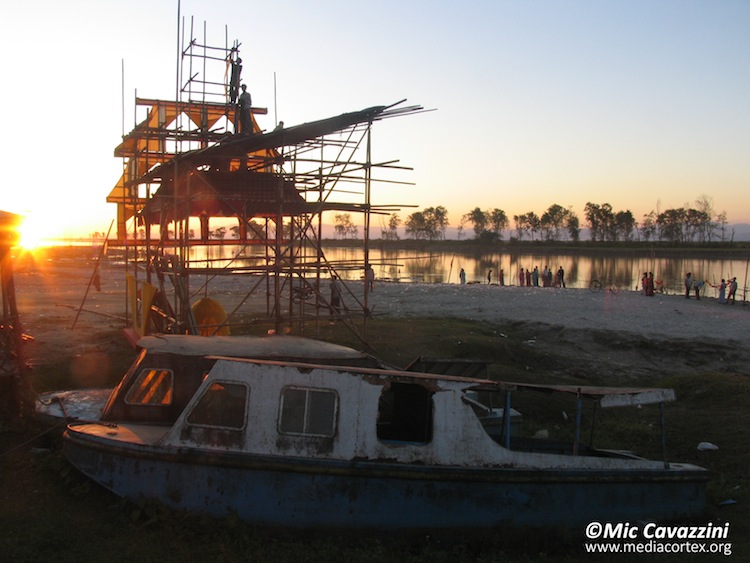
Manikarnika is just one of 50 ghats stretching for over three kilometers along the western bank of the Ganges overlooked by monumental walls of palaces and temples. Some built by kings in the 1700s, others by more recent political figures and captains of industry. Perhaps they were something like the ‘indulgences’ the rich in medieval Europe paid off to the church to have their sins forgiven. The ghats are teeming with activity: People dunking themselves in blessing, men scrubbing the flanks of their buffaloes, kids playing cricket, boatmen hustling for business and the roaring flames of the funeral pyres. This has all been described by many others before me, but the resounding impression for me is the rich intermingling of spiritual and daily life. Almost every temple has its own evening harati ceremony- some populated by scores of worshippers and others low key and intimate. But people and animals wander in and out and there is no heavy solemnness…. it seems that reverence is constant and infused in much of daily life anyway.
Being a touristic place there are a plenty of beggars here as well as hawkers. Some are pitifully disfigured, others are adorable children you suspect are doing the dirty work for some shady Fagan who takes their spoils from them. It seems that the foreign tourists are hassled more persistently than the Indian ones, and I wonder if it’s due due more to their wealth or their generosity. I ask Ravi- an energetic guy of my age who runs a guest house and is a respected tabla player and teacher. The proceeds from his hotel go to funding a village school, so I ask him whether he gets many contributions rich Indians. “Oh it’s terrible. Charity is not really a part of the culture here. People feel like they’ve earned their right to be wealthy whether by working hard in this life, or merit from a past one. They don’t really see the community as their own responsibility.” What about the government? If it can send a mission to Mars does it invest much into development? “There are some programs but I steer clear of them. Say you need 30 000 rupees to keep the school going. You have to ask for 50 000 instead so you’re able to pay off all the people that are going to request a cut. I’m just don’t want to play that game.”
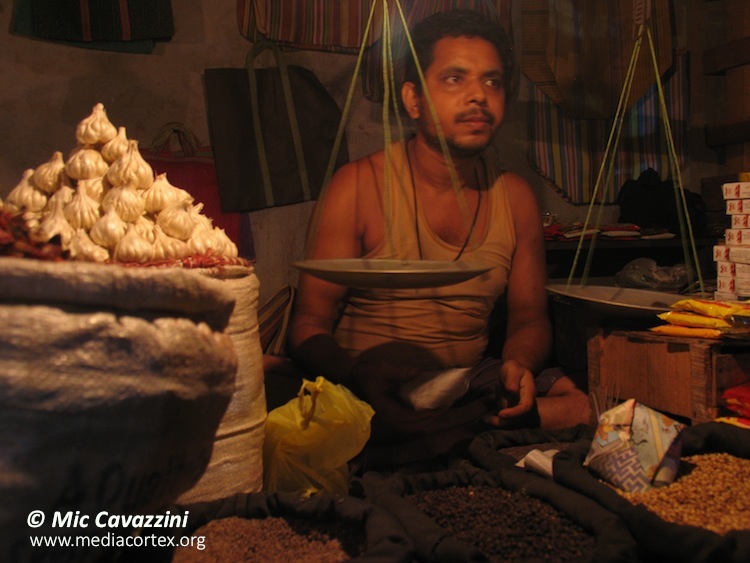
This month is luckiest time in the Hindu calendar to get married, so several times a day I hear the beating of drums as a parade goes by, the hired boys dressed in marching band style. Sometimes there is a wedding on each end of the street, or a cluster of young men gyrate drunkenly to cheesy dance music around stacks of loudspeakers. But my most suprising impression of Varanasi comes as I return to my hotel one evening. In the warren of dark quiet lanes I hear some gentle singing. A few female voices coming from a window grill at ground level. I peer through and in the dim candle light see only the headscarves of five women who have their backs towards me. On the far wall is a wooden cross…. and sure enough one of the women then carries a dish to each of them offering the Christian communion. The peaceful hymns are not any melody that I recognize, and the bells they chime are they same the swamis wield by their temples.
In general it seems that communities of Christians, Muslims and Buddhists thrive alongside Hindus without conflict. There have been well-known clashes and political tirades, but in everyday life you often see people of different faiths chatting to each other and just getting on with life. I’ve asked by adherents of each of these faiths what I myself believe in, I choose not to present myself as a soulless atheist. Instead I respond that the mountains and the rivers are my temples, and that that is where I feel the most powerful energy. This answer always seems satisfactory, and they chime in how meditation through nature is one of the ways of reaching god or enlightenment. I nod my head sagely and regale them with the tale of the four blind men and the elephant. Each man would try and describe the elephant to the others- but one would be holding the trunk, the other an ear or a tail…. That is what each religion is like, trying to describe ‘their’ god.
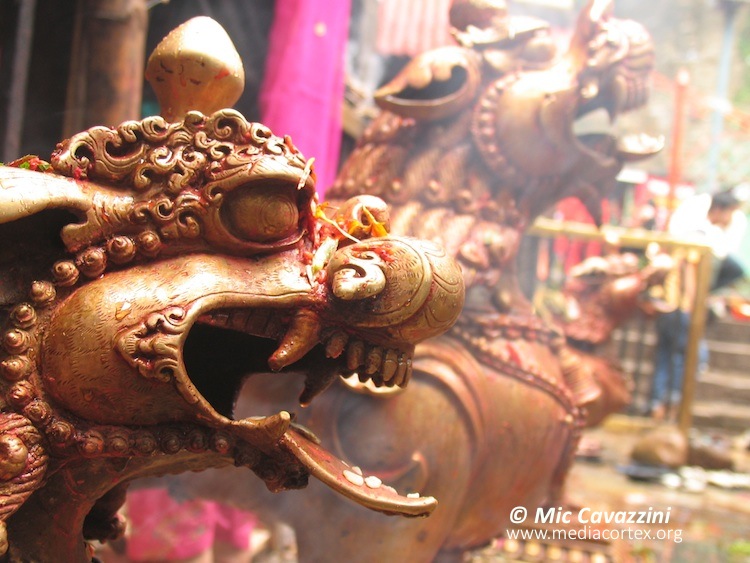
The next leg to Chitrakut passes through baking plains broken occasionally by lines of mango trees that provide some shade for the field workers. The temperature is over 40 degrees and there isn’t a breath of wind. The hamlets rise from the dust- simple one room dwellings with an animal pen attached. The rooves seems tiled with cowdung. Everywhere there are towers of dried dung that is later used to keep the kitchen fire going. But there is a depressing listlessness out here. Whether the people are toiling in the fields, or collecting water from the pumps, or cycling the cracked road towards the next town, everything moves in a hazy half-time and without any obvious purpose. The rural poverty is a slap in the face in comparison to what I’d seen in the hils, where people have two story brick houses and solar panels paid off by lucrative cash crops.
Chitrakut itself stands oddly in the middle of this. It is described as the ‘mini-Varanasi’ because there is a short section of the river Mandakni that is studded with ashrams and temples. The ghats of only a few hundred metres are lit by lurid orange street lights and busy shop stalls selling religious offerings. . It has an eery fairground feel. While boats with fairy lights drift up and down the river for the pilgrims devotional songs echo hauntingly from the loudspeakers on both sides of the river. The songs are taken from the epic poem the Ramayana, since it’s said that Rama took refuge here for eleven and a half years of exile. I figure out that Rama is a reincarnation of Vishnu but the rest of the tales are so elaborate and there are so many names and overlapping reincarnations I soon give up.
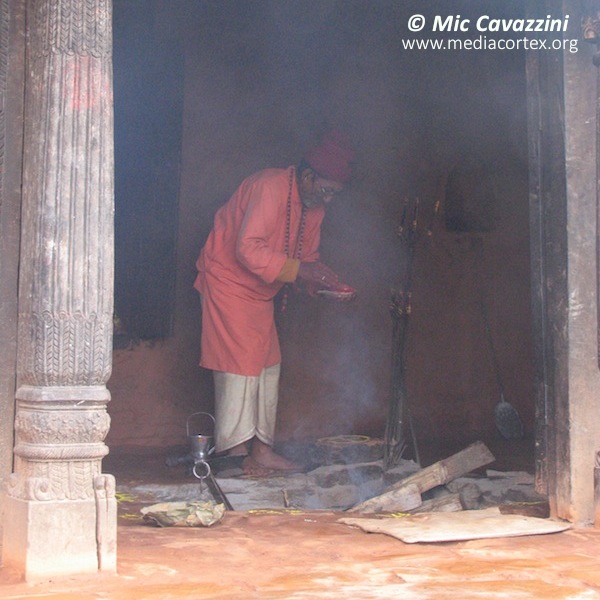
There are tall ornate arches leading into courtyards stopped in time. Sometimes only a movement or a sound will alert you to the fact that there is person stretched out in a shady corner. Maybe a gaunt and ancient nun with a shaved head staring into the middle distance, sunken eyes and hanging skin. Or two men in loin-cloths sharing wooden bunks in a small room. When they do speak they mutter the words “Aum Sita Ram” almost under their breaths. Life for these sects is a constant blessing to the lord Rama. They all just seem to wait- and perhaps that is the secret. They are in no hurry. They recite their mantras day in day out and both live deeply within each moment as well as being somehow outside it. Time is a contrivance of the mortal life- and they seem happy to wait for death in a place of such spiritual power.
The guest house is set on the terrace of a small ashram and my host is the peculiar Varun. He says his father was a swami before him, and his father and so on back for ten generations. They are Brahmins and are basically born with the responsibility to keep the temple alive and the devotional rituals going. Varun younger than me, but does carry a certain presence from all his meditation and deep spiritual knowledge. When I tell him of my stolen camera he taps the back of his head and says, “You have a great camera up here.” But there’s also a distraction and indolence about him. He talks of the community project he’s trying to get going but I hear later that this has been a failure and that he and his brother are incapable of managing their financial affairs. The hostel kitchen that had been attempted also went down the drain, and the rooms are the worse I’ve seen on my entire trip. Perhaps being born into such a privileged position within the community breeds some apathy- like the spoilt private-school kids (ahem) of our own culture.
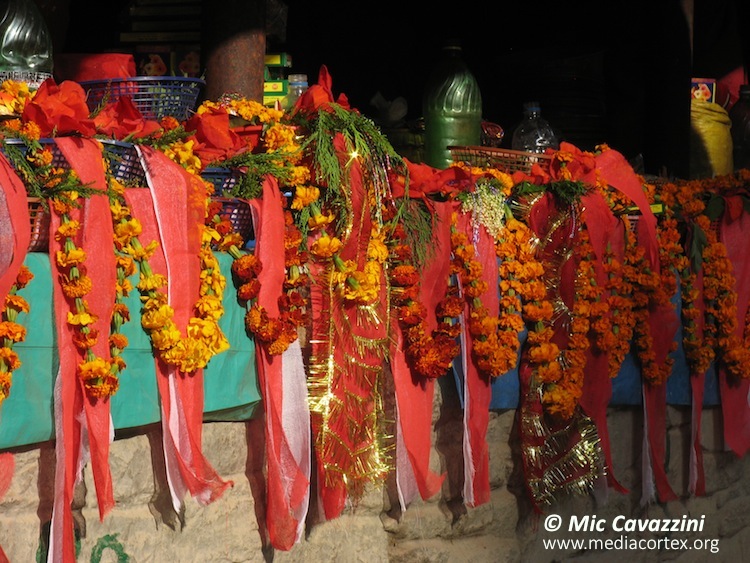
My trip nears its end towards Agra, which was of course a seat of Muslim, Mughal power. The nearby palace complex of Fatepur Sikri is a fortified city carved from red sandstone, but laced with elegant porticos and balconies and pools, and giant stables said to have housed a harem of 5000 courtesans. The Sufi shrine within the complex pulses with energy. I am handed a white skullcap and told to process clockwise around the tomb of this long-dead saint. The supplicants pack into the small chamber with marble filigree windows and drop to their knees. There is a fervor here that charges the air. In a way it feels more tangible than that of the Hindu temples, because it is directed towards once-living saints. And there is a real emotion in the almost tearful eyes of these people, whereas in many of the Hindu temples the visitors seem to be listlessly ticking off a duty, or tossing in a superstitious donation to ensure their own future fortune and prosperity.
The outskirts of Delhi are like an overgrown semi-industrial badlands, but then every kilometer there rises a high rise tower complex each with a dreamy name like “Silver City” or “Vaatika Heights”. And most of the advertising billboards are all for the such-and-such university, or polytechnic or education trust or the successful “Boom Devi Group of Institutions’. Education is an aspirational industry and the names become more and more contrived to give an air of the esteemed and the exotic. There is a Cambridge International School, and a Trinity Medical College and the posh Britishy language also filters into instructional signs; the “Reception cum ticketing office;” “Please avail yourself” of this service; “trucks will by plying the route.” This must be the English that was taught seventy years ago when the British handed the Raj back to the Indians.

But the most disconcerting element of the advertising are all the white faces. Signs for nursery schools that show grinning blond Caucasian kids, copied from some western website or stock photo library. Worse are the ads for “Everglow Fairness Cream” with whitening crystals or magic enzymes. There are several such products targeted at both men and women and it’s no surprise. One look at the big Bollywood films and all the actors have a radiant European look to them. The hottest star of the industry is a Latina. Strange that the concept of beauty being peddled by Bollywood is the same one forced down our throats.
I have only one day to get an impression of Delhi. My ‘in’ to the city is a young gay designer who shows me a city I had not expected; A hipster neighbourhood full of indie fashion stores and themed bars. After months of eating insipid curries at best, or daal and rice day in day out, my eyes water at a phenomenal meal of fusion cooking. And I’m astounded at the efficiency and cleanliness of the metro system- New Delhi is a very modern city, no cleaned up especially for the Commonwealth games. I’ve no doubt that the chaos and traffic and poverty are not far away, but I’m left with a buoyant feeling about India’s possibilities. The young people I meet studying environmental economics and social politics. The fact that these young people have hope for solving their country’s problems is encouraging- there is much more than wealth and beauty that they aspire to. I only pray that don’t become apathetic or cynical at the chronic corruption that rots all levels of government. I’ve only traveled across four states out of thirty six, but I feel like I’ve gotten a small way into the head of this kaleidoscopic country.
***
May 2015

